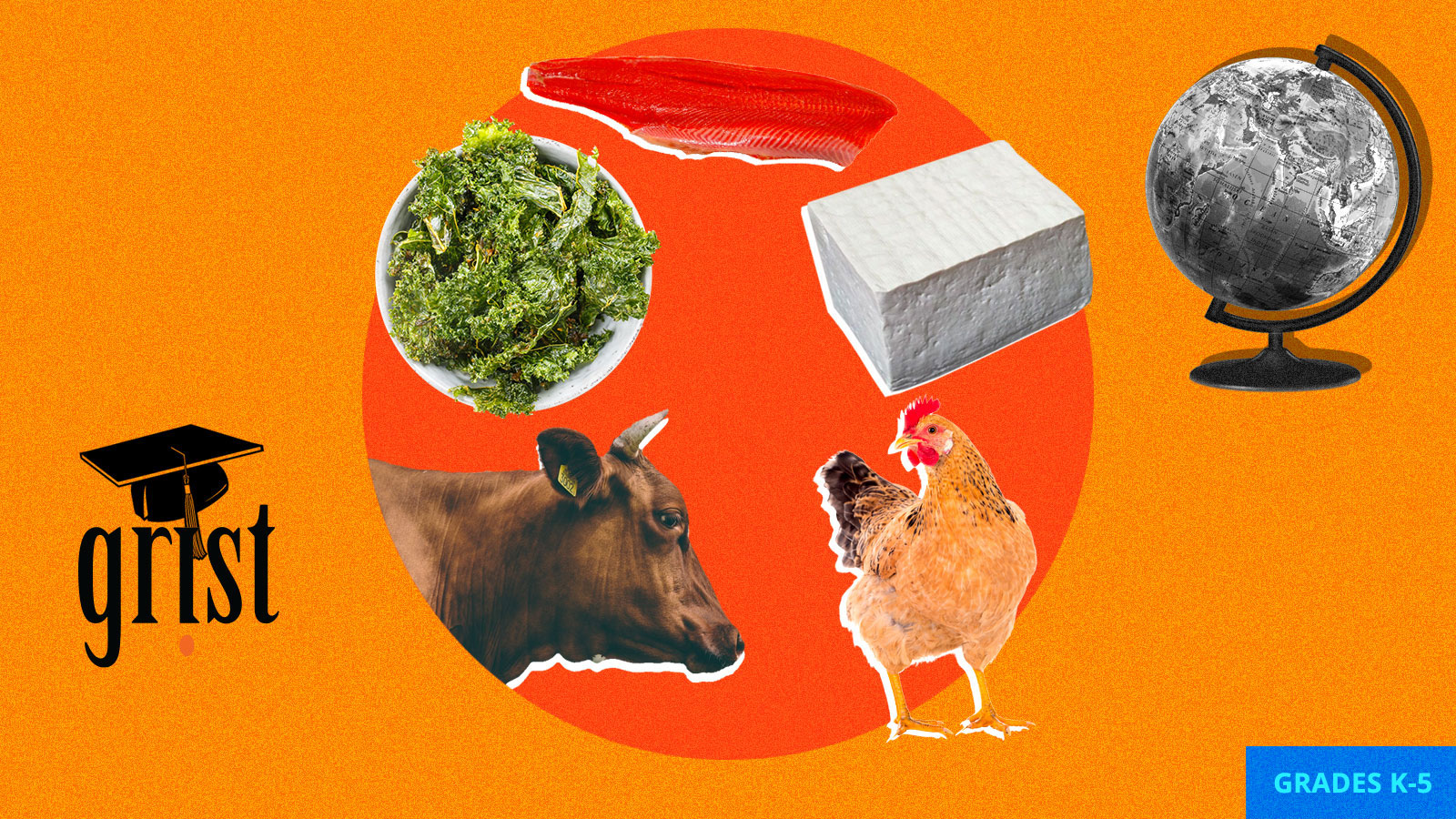This lesson is part of our Climate 101 educational series for parents and K-12 educators.
Hey parents! Do you find yourself wanting to talk to your elementary school-age kids about climate change, but you’re not sure where to begin?
Don’t worry, you’re not alone. Your children may be too young to read by themselves or, you know, wrap their head around the intricacies of global climate policy, but there are age-appropriate ways to introduce the idea that we should — and can! — take better care of our planet.
And what better way to start than with food! Every one of us eats, so everyone poops has the ability to take action on climate change. Cooking with your kiddo is a great way to introduce them to climate-friendly values such as thinking about where their food comes from, trying new (low-emissions) foods, and cutting down on food packaging and waste.
We scoured our video archives and rediscovered three of our favorite Grist Test Kitchen clips to use as jumping-off points to introduce your child to the concept of climate change. We’ve also come up with suggestions of what to do and say to help you connect the dots between food and the environment.
Level: Preschool to 5th grade
(Note: If your kid is very young or isn’t a fan of sitting still, you may want to skip the videos and go straight to the activities.)
Make an energy-efficient snack
It may not be Hanukkah season right now, but it’s still a great time to make these delicious vegan latkes with your little one. They can help grate the potatoes, apples, beets, etc., while you handle the frying process.
Say: “Just like food gives us energy when we eat it, it takes energy to grow food. Growing some types of foods uses a lot more energy than others, and that’s not great for the planet. In general, plants use up less water, for example than meats like beef or pork.”
Activities:
Do: Make Latkes! Grist staff writer Eve Andrews offers three different variations for your pleasure. (Not a fan of fried food? Try this two-ingredient fruit leather.)
Traditional (potato) latkes:
- 2 russet potatoes
- 1 medium onion
- ¼ cup all-purpose flour
- 1-1½ tsp salt
- ½ tsp ground black pepper
- 1 egg, beaten to blend
Beet latkes:
Recipe courtesy of Bon Appetit
- 4 medium beets (enough to yield 4 cups shredded beets)
- ¼ cup all-purpose flour
- 1 teaspoon salt
- 1 teaspoon ground cumin
- ½ teaspoon ground coriander
- ½ teaspoon baking powder
- ¼ teaspoon ground black pepper
- 2 large eggs, beaten to blend
Apple latkes:
Recipe slightly adapted from Smitten Kitchen
- 1 pound Granny Smith apples (or similar)
- 1 tablespoon lemon juice
- 6 tablespoons all-purpose flour
- 2 tablespoons granulated sugar (recipe originally calls for half of this, but we thought these weren’t sweet enough)
- 1/4 teaspoon cinnamon
- 1 teaspoon baking powder
- 2 large eggs, beaten to blend
Here are the basic steps:
-
Peel your vegetable of choice and shred. I used the grating attachment of a food processor, because I’m lazy efficient. You can also use a box grater. (Special note: For traditional latkes, I pulse the shredded potatoes and onions in the food processor a couple times so the consistency is a bit more mealy.)
-
Drain liquid from shredded vegetables. I do this by tossing them a few times in a colander, and then laying them out on paper towels if I’m feeling particularly ambitious.
-
In a mixing bowl, combine shredded vegetables with remaining ingredients — a combination of flour, salt, pepper, spices, and eggs. (See ingredients list for exact measurements, but feel free to experiment to your liking. And For apple latkes, lemon juice should be added before all other ingredients, and we let the shredded apple marinate in the lemon juice for a few minutes.) Stir to mix. All ingredients should cling together, but not be too wet.
-
Cover the bottom of a heavy pan (cast-iron is ideal) with roughly ¼ inch of vegetable oil, and place over medium-high heat. You want the oil to be hot enough that a splash of water spatters when it hits the pan, but not so hot that the oil is smoking.
-
Add latke batter by spoonfuls — you don’t want them to be too large or too thick, so I always pat them down a bit in the pan. Fry until browned and crispy on each side, and remove to drain excess oil on paper bags (which absorb oil way better than paper towels).
-
If you don’t eat them immediately, you’re stronger than I am, but latkes can be kept warm in the oven and also are excellent when reheated after being frozen.
While your latkes fry, what are some other yummy plant-based foods or snacks that you would eat? (Draw a picture or use a recipe book with pictures to mark out ideas for your next energy-efficient meal.)
Discuss: No matter what kind of foods we eat, one of the best things we can do for the planet is to not waste food. (Tip: You can reuse the oil you used to fry the latkes!) What are some ways you might reduce food waste at home?
Examples: Use smaller plates (so you eat smaller portions), take only what you will eat, eat leftovers, or cut typically wasted foods, like broccoli stems, into fun shapes to encourage snacking
Rethink the way you pack your lunch
This Grist video is a bit of a throwback, but young kids will still relate to its main message: You can redesign your lunch to be better for the planet by trading packaged foods and meat for healthy ingredients you can fix at home. (We know this isn’t an option for everyone, but if you’re able, give it a shot.)
Say: “You don’t have to give up meat completely to do something nice for the planet. Even swapping out one meal per day for a meatless feast can make a difference.”
Activity (probably better for older elementary school kids):
Do: Plan a meatless (or low-meat) feast. Draw each food item and create your own colorful menu. You can even make video reviews of your recipes to preserve your family’s reactions!
Skip the store-bought junk food
Encourage your kids to keep more of those disposable snack-food bags out of the trash by trying to replicate some of their favorite packaged snacks at home. Look online for good recipes for DIY fruit leather, goldfish crackers, tortilla chips, etc.
Say: “When we eat foods that come with a lot of packaging — plastic or other containers that get thrown away — that’s not great for the planet. By cooking more at home we can skip the packaging and usually come with a healthier version!”
Activity:
Do: Dupe your child’s favorite packaged snack with a fun DIY. If you’re feeling especially daring, why not try convincing your potato chip-loving little one to try some of the delicious kale chips featured in the video above.



